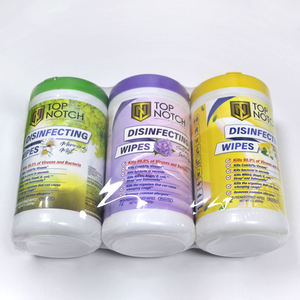(2823 products available)
























































































































































































































 Ready to Ship
Ready to Ship























Canned wet wipes are convenient and practical hygiene products that come in a sealed container, keeping the wipes moist and fresh. There are various types of wet wipes in cans, each designed to suit different needs and preferences:
Baby Wipes:
These are specially formulated for a baby's delicate skin. They are usually alcohol-free and have gentle, soothing ingredients like aloe vera and chamomile to prevent diaper rashes and skin irritation. Many baby wipes are dermatologically tested and safe for newborns. Some even have special markers for easy differentiation between baby wipes and adult wipes.
Antibacterial Wipes:
Infused with antimicrobial agents like benzalkonium chloride, these wipes kill many germs on the skin's surface. They are effective in reducing bacteria and help prevent the spread of infectious diseases. Antibacterial wipes are great for cleaning hands and surfaces, especially where soap and water are unavailable. They are also labeled to know whether they are safe for use on skin and surfaces.
Beauty and Facial Wipes:
Facial wipes are designed for facial skin and have cleansing, moisturizing, and nourishing properties. They are commonly used in the makeup removal process and have ingredients like vitamins, antioxidants, and natural extracts that benefit the skin. Other types of beauty and personal care wipes include anti-aging, refreshing, and exfoliating wipes that cater to different skin needs.
Personal Care Wipes:
These wipes are designed for adults and are typically used for cleaning the genital area. Some wipes have alcohol, which can cause skin irritation, while most are alcohol-free. They help provide a refreshing feeling and maintain personal hygiene. Some wipes are marketed toward men, while others are geared toward women. Some personal care wipes are infused with soothing ingredients like aloe vera, chamomile, and vitamin E.
Household Cleaning Wipes:
Canned wet wipes are also available for household cleaning. These wipes are designed to clean and disinfect various surfaces in the home, such as countertops, appliances, and bathroom fixtures. They often contain powerful detergents and disinfectants that remove dirt and germs. Some cleaning wipes are even specially formulated to tackle tough stains and grime, making them a staple in many households for quick and easy cleaning tasks.
When choosing disposable wet wipes in cans, there are many factors to consider. Below are some of these factors:
Wet wipes have many uses and applications. Users can use the wipes to clean their skin, especially babies, and the elderly. The wipes are also good for cleaning surfaces, equipment, and tools. The moist wipes in cans are handy and easy to use. Users just need to pull one out of the container. They are also good for quick cleaning and are very convenient.
Although wet wipes are very useful, they have some risks. This is especially true when users don't follow the correct procedures. For example, some wipes have chemicals that may irritate the skin. Also, some wipes have alcohol, which can cause a burning sensation. In some cases, using wet wipes may trigger allergic reactions in some people. Users must read the label on the wet wipes to know the ingredients. They should also follow the guidelines on the packaging to reduce the risks.
Another risk is the possibility of flushing the wipes. Many users think they are the same as toilet paper. However, most wet wipes do not break down like regular toilet paper. They can clog up toilets and cause major plumbing problems. In some cases, the wipes can create blockages in sewage systems. The only wipes that are okay to flush have clear labels saying “flushable.” Even with this label, it is still best to discard the wipes in the trash.
Users should also be mindful of the alcohol content in the wipes. High alcohol wet wipes are highly flammable and can pose a fire hazard. It is best to keep the wipes away from fire or open flames. Also, avoid using the wipes near electrical appliances like toasters and generators. Children and pets are curious, and they may want to touch the wipes because they are wet and moist. So, it is important to store the wet wipes safely.
Q1: Can alcohol be added to the wet wipes?
A1: Yes, alcohol can be added to wet wipes, especially if they are intended for sanitization purposes. The concentration of alcohol should meet the desired standard of the alcohol content.
Q2: What are the minimum order requirements?
A2: Manufacturers have different minimum order requirements. It can range from 1000 to 5000 depending on the type of wet wipes in cans and the customization options.
Q3: What is the shelf life of wet wipes in cans?
A3: The average shelf life of wet wipes in cans is 2 to 3 years. This depends on the type of wet wipes, the ingredients used, and whether preservatives are added.
Q4: Are there sustainable wet wipes in cans?
A4: Yes, there are wet wipes in cans made from eco-friendly materials. This includes biodegradable non-woven fabrics and recyclable plastic containers.